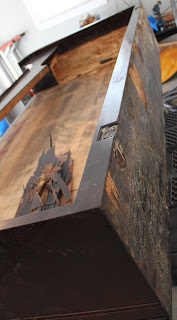This entry is a continuation of the previous two. If you haven't read them, you should check them out.
Or, be confused. What do I care?
 |
| The last pile of chunks in an otherwise empty shell of what was once, a piano. |
 |
| Veneer off. Notice the fragments, sitting inside to the left... |
That means, I pulled off the obvious slivers and gouged pieces that made
the surface uneven and then used my oscillating tool and 60 grit sandpaper to
clean up every newly exposed surface.
 |
| Exposed: The gutted result. As much as bar as a piano, or a casket, or, or, or... |
I then deposited one whole sixteen ounce
can of wood filler into the crack and gaps, starting on the left of the case.
That left me with no more wood filler, and two-thirds of the piano yet to be
patched. (Not to mention I have to glue the case together again.)
 |
| Weighing chunks. A pound here, a pound there, and soon, you're talking heavy! |
It doesn't sound like much,
I know, but you can look at the pictures and see, it really was four full
weekends of work just to get that far. Finally, though, the cosmetic (and
comparatively easy) work can now begin.
 |
| Patching has begun. Long, long way to go, I know. |
By the way, the bruise on my
hand? It formed a lump that I ended up taking to my doctor. He says I
definitely fractured a bone in my hand when I hit it with the hammer back in
late June. Some of the other bruises that were not broken bones are shown in
the photo below.
 |
| You don't have to look too close to see my arms are pretty mangled. |
I haven’t thrown out all the
pieces of the piano that I removed. Yet. I’m saving select things in case I find
some use for them as I assemble the piano into a bar. If I don’t, out they go.
I still have to drive all the metal to the scrap yard and collect my $20 (?)
for that.









